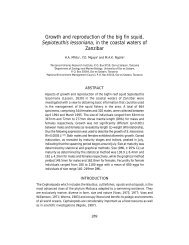gpa_east_africa_case.. - GRID Africa GeoPortal - UNEP
gpa_east_africa_case.. - GRID Africa GeoPortal - UNEP
gpa_east_africa_case.. - GRID Africa GeoPortal - UNEP
Create successful ePaper yourself
Turn your PDF publications into a flip-book with our unique Google optimized e-Paper software.
Disentery 5,200 (>1.0%)Cholera 1,500 (>1.0%)Typhoid 400 (>1.0%)Total 590,100 (100%)Malaria has the highest incidence (55%), while cholera the highest cause of death. On thebasis of the above figures, 118,000 <strong>case</strong>s of disease on average are reported a year(590,100 / 5 years). At an average cost of treatment of $13 per person, the cost of treatmentmay be estimated at $1.5 million a year. The loss of income from work-days lost, assumingonly about 50% (59,000 persons) are of working age, may be estimated at $1.6 million(59,000 x $27.0 loss of earnings for 15 days), totalling $3.1 million a year. Despite highunemployment, the availability of informal sector jobs would account for the assumed incomeloss. Infant and child mortality is reported to be 102/1000 and 163/000 per year respectively.If the population size of the age group 1-5 years old is about, say, 15% of the total populationof 3,500,000, the relevant population group amounts to 525,000 children, implying roughly anannual child mortality of between 53,550 and 85,575, or a mid-value of 69,500. The economicapproach to the valuation of losses from death is controversial as it may give the impressionof placing a value on human life. The economic approach focuses not on the value of life perse but on the cost arising from loss of productive years caused by death. On this basis, it ispossible to estimate the partial losses arising from child mortality. There are two mainvaluation methods to estimate the economic impacts. One is to estimate the willingness topay for improving sanitary conditions and avoid exposure to environmental-related causes ofmortality (differential risk or risk avoidance method) measured by the difference in thewillingness to pay for safe relative to unsafe sanitation and living conditions. The othermethod (the human capital method) relies on the estimate present value of loss of futureearnings. The human capital approach is much simpler and less dependent on detailedinformation. At an average wage of $650 per year, the estimated annual cost of loss of futureearnings for 69,500 children, starting 15 years after death (if death was avoided), is $45million. Since this income loss will occur in 10 years the present value of this cost today (ifdiscounting is applied - 10 years at 10%) is equivalent to $17.3 million per year.Indirect CostsTable 12: Health annual cost summaryTreatment cost$ 1.5 millionLoss of income during illness $ 1.6 millionLoss of earnings due to death $ 17.3 millionEstimated total$ 20.4 million5. RecreationRecreation benefits concern the enjoyment of coastal areas of natural beauty by the nationalpopulation. Tourism benefits have been considered above. Often, there is no market forrecreation in open access areas and valuation of such environmental services would need tobe based on information revealing the social valuation of recreation opportunities to the localpopulation. Such valuation would reflect the indirect benefit from the “services” ofenvironmental quality. There is no such information available from previous studies in East<strong>Africa</strong>. To estimate recreation benefits would ideally involve calculations of how much peoplewould be willing to pay to have access to recreation areas of a certain level of quality,requiring a survey of social preferences. However, recreational benefits are as real andimportant as direct benefits and cannot simply be ignored. In the absence of any informationon how many people visit coastal or marine parks for recreation and indications of proxyprices, such as entrance fees or travel costs, it is reasonable to classify this source of benefitas qualitative. The interesting question here is to investigate on the basis of a questionnairehow much the local and the national population would be willing to pay to ensure that thecoastal environment is preserved through coastal management actions including sewerageinfrastructure. Lack of information should not encourage an attitude of ignoring recreationalbenefits because that would imply putting a zero value on recreation enjoyment, which isclearly misleading.Final Draft Report – Cost Benefit Case StudiesGPA Strategic Action Plan on Sewage, October, 200037


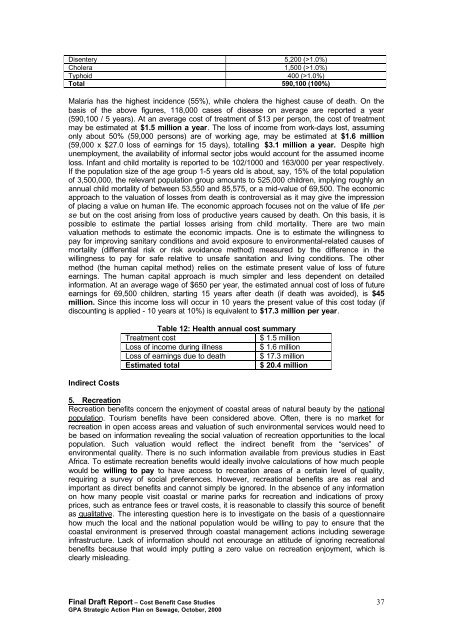
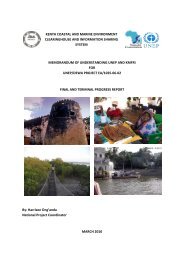
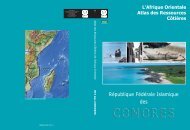
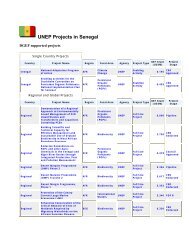

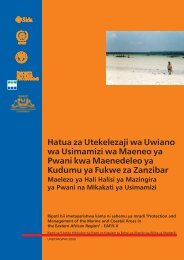
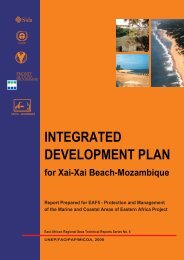
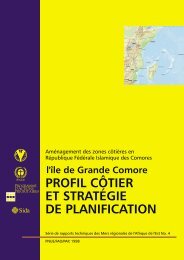
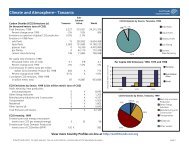

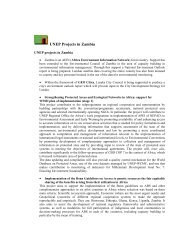
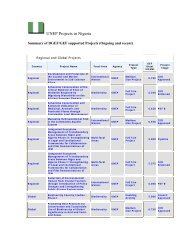
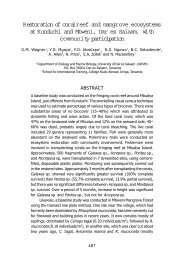
![Please Click to download [English] - GRID Africa GeoPortal - UNEP](https://img.yumpu.com/30633391/1/184x260/please-click-to-download-english-grid-africa-geoportal-unep.jpg?quality=85)
